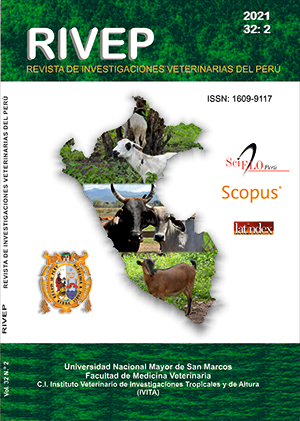Assessment of quality, bromatological and in vitro fermentative characteristics at different times lactic fermentation of ripe mango silage
DOI:
https://doi.org/10.15381/rivep.v32i2.18343Keywords:
ripe mango, pangola grass, silage, lactic fermentation, ruminantsAbstract
The aim of this study was to evaluate the quality, bromatological and in vitro fermentation characteristics of ripe mango silage between 28 and 168 days of lactic fermentation (LF). The silos in bags (20 kg) were made with 80.64% mango, 11.38% pangola grass, 4.55% corn stubble, 2.04% molasses and 1.36% urea. The opening time of the silos was at 28 (T1), 44 (T2), 97 (T3), 113 (T4), 126 (T5), 140 (T6), 154 (T7) and 168 (T8) d of LF. It was determined pH, lactic acid, dry matter (DM), crude protein (CP), neutral detergent fibre (NDF), acid detergent fibre (ADF), hemicellulose, biogas and methane (CH4) production, ammoniacal nitrogen (N-NH3), pH of the medium, total bacteria count, dry matter degradation (DMD) and neutral detergent fibre degradation (NDFD). The statistical analysis was under a completely randomized design. The content of DM, pH, ADF and hemicellulose did not show differences by FL time of the silage (p>0.05). T2 presented higher lactic acid content, without differences with T1, T3 and T4 (p>0.05). T1 showed higher CP content than T2, T4 and T6 (p<0.05); without differences with the rest of the treatments (p>0.05). The accumulated biogas production was not affected by the FL time of the silage (p>0.05). CH4 production after 72 h of incubation was lower for T4, without differences with T1, T3 and T5 (p>0.05). The highest DMD was for T1, T2, T3, T7 and T8 (p<0.05). The lowest NDFD was for T4 and T5 (p<0.05). Under these conditions, it is concluded that ripe mango silages can be lactic fermented for up to 168 days without affecting their in vitro quality, bromatological and fermentative characteristics.
Downloads
Downloads
Published
Issue
Section
License
Copyright (c) 2021 Nicolás Torres Salado, Marcelino Gómez Trinidad, Paulino Sánchez Santillán, Adelaido Rafael Rojas García, María de los Ángeles Maldonado Peralta, María Benedicta Bottini Luzardo

This work is licensed under a Creative Commons Attribution 4.0 International License.
AUTHORS RETAIN THEIR RIGHTS:
a. Authors retain their trade mark rights and patent, and also on any process or procedure described in the article.
b. Authors retain their right to share, copy, distribute, perform and publicly communicate their article (eg, to place their article in an institutional repository or publish it in a book), with an acknowledgment of its initial publication in the Revista de Investigaciones Veterinarias del Perú (RIVEP).
c. Authors retain theirs right to make a subsequent publication of their work, to use the article or any part thereof (eg a compilation of his papers, lecture notes, thesis, or a book), always indicating the source of publication (the originator of the work, journal, volume, number and date).










